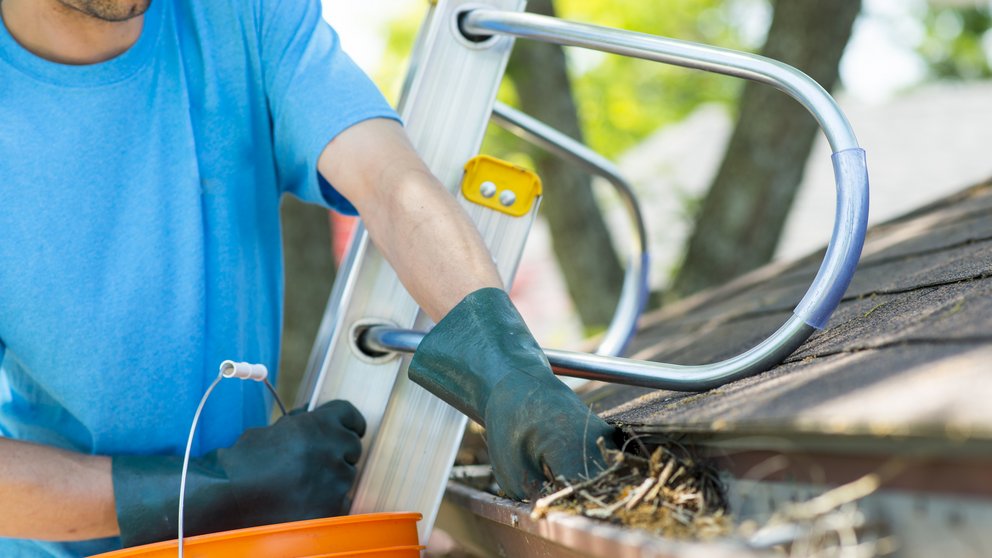
Gutters can be easy to overlook. But they can get clogged with decaying leaves and other organic matter, leading to damage and expensive repairs that your home insurance won’t cover.
Inspecting and cleaning your home’s gutters is crucial
Here are some top reasons gutter maintenance is a big deal for your home and budget.
Prevents roof, siding and foundation damage
Clogged gutters mean water can’t drain away from your home, leading to water overflow. Water that flows toward your house or pools can cause severe damage to the roof, siding and foundation.
Deters basement flooding
Clogged gutters can’t effectively direct rainwater away from your home. This can lead to basement flooding and mold growth.
Discourages pests from moving in
Gutters filled with decaying leaves are attractive to pests such as insects, birds and rodents. Over time, these pests can invade your home, causing damage and costly extermination expenses. Home insurance doesn’t cover infestations.
Protects your landscaping
Misdirected rainwater from clogged gutters can wash away or drown your plants, or erode your soil. That can drain your property’s curb appeal and your bank account.
Keeps your gutters in place
The extra weight of blocked gutters can cause them to pull away from the house, damaging your roofline, fascia and soffits. Simple gutter maintenance can help prevent expensive repairs down the road.
Reduces ice dams
Clogged gutters can fill with water and freeze in colder months, forming ice dams. Ice dams can force water underneath your roof shingles, causing rot and leaks. They also add weight to your roof, causing premature wear and risk of collapse.
If you make an insurance claim for home damage
Insurance doesn’t cover damage resulting from lack of maintenance or misuse. Damage caused by dirty gutters is a hard sell for insurance claims.
If you make a claim, your insurance company will send a claims adjuster to inspect the damage. They’ll look for patterns to find a root cause of the loss. They’ll deny the claim if they find evidence that gutters were the culprit.
You can appeal the claim denial, but you’ll need proof to bolster your case. Hiring an independent insurance adjuster can help. An independent adjuster isn’t associated with your insurance company and works for you. They’ll evaluate the damage, take pictures, review the wording in your policy and help you with your appeal. Just make sure to appeal within the period specified in your claim denial letter, usually 14 days.
Gutter cleaning supplies
If you’re cleaning your gutters, have these tools on hand:
- An extension ladder. Never use a damaged or worn ladder. You risk falling and injuring yourself.
- A standoff stabilizer. Stabilizers keep ladders from wobbling and protect gutters from the weight of the ladder leaning on them.
- A dust mask. Use a high-quality respirator, like an N95, to filter out small particles and mold spores.
- A tarp or ladder utility bucket. Placing a tarp on the ground near the ladder makes debris cleanup easier. If you use a bucket, make certain it’s safe to hook onto your ladder.
- Goggles. Use wrap-around goggles to keep debris from falling into your eyes. If you use a face shield to protect your face, wear goggles underneath for complete eye protection.
- Gloves. Choose sturdy rubber or synthetic-coated gloves that you’re comfortable in and that protect your hands from sharp debris. Beware of latex allergies when choosing gloves.
- Nonskid shoes. Choose closed-toe shoes with nonskid rubber soles for a solid grip on ladder treads.
Ladder safety tips
Invest in a quality ladder. You might have different ladders for different jobs in your home. Outdoor work requires an extension ladder with anti-slip feet. Inspect your ladder every time you use it. If it’s damaged, discard it.
Check the ladder’s weight rating. Make sure it can hold your weight and the added weight of the materials you’ll be transporting. For example, if you decide to paint your gutters after you clean them, you’ll need to factor in the added weight of the paint cans.
Maintain three points of contact on the ladder; if you have to reach or lean so far that both hands leave the ladder, it’s time to dismount and reposition it. Get a friend or family member to hold the ladder and monitor your safety.
Choose a grounded or fiberglass ladder that doesn’t conduct electricity. This will help prevent electrocution. But don’t be lulled into a false sense of safety because your ladder is nonconductive. You can still get electrocuted by an arc flash.
Before you set up your ladder, check the area for power lines. Stay at least 10 feet away from overhead power lines. You don’t have to make contact with overhead electrical lines to be in danger. Electricity can jump its intended conduction path (the power line) and travel through the air in search of a new conductor, similar to how lightning travels the air. It’s called an arc flash, and it could kill you. If you must work near power lines, contact the utility company to discuss your project.
Never use a pressure washer while on a ladder. Only use pressure washers while standing on the ground. Pro tip: If you’re using a cleaning solution in your pressure washer, make sure it’s safe to use around plants and shrubs.
Hire a professional and check your insurance
If heights and ladders aren’t for you, hire a professional. Gutter cleaning services generally cost anywhere between $70 and $600, depending on the number of stories your house has and the complexity of your gutter system. A reputable service will have insurance coverage, but verify they have it by requesting a certificate of insurance from them. Ensure your home liability insurance is active, too.
Make gutter cleaning part of your maintenance routine, particularly after your trees shed their leaves. You’ll prevent expensive problems and help maintain the structural integrity of your house. That’s a good return on investment!
